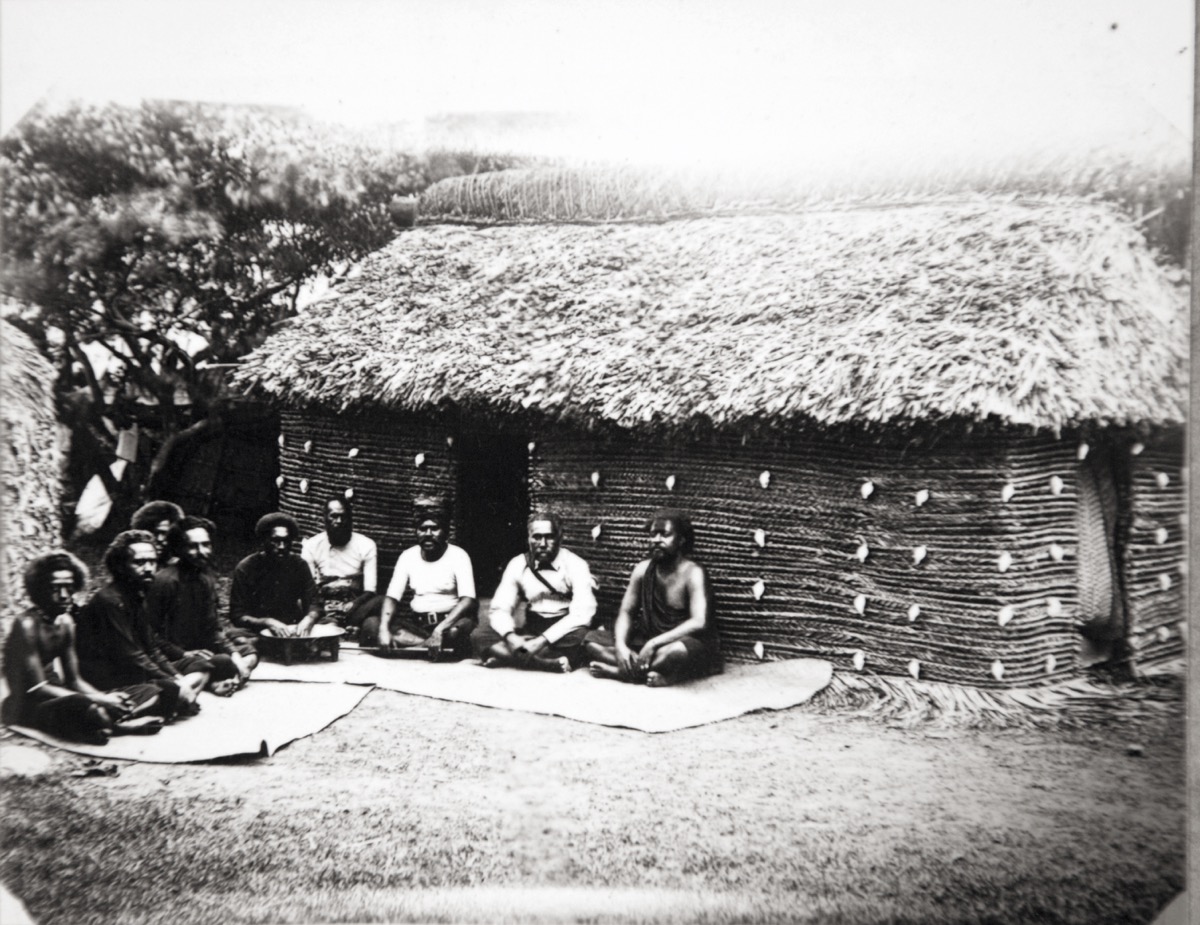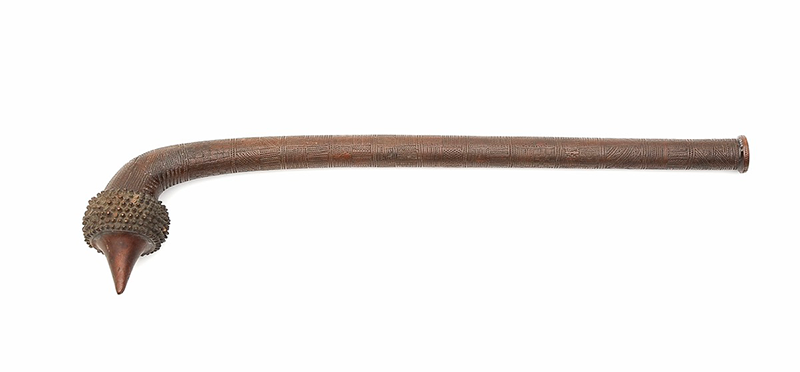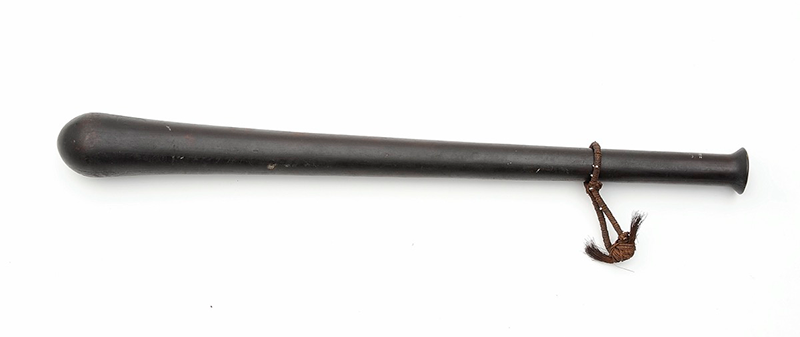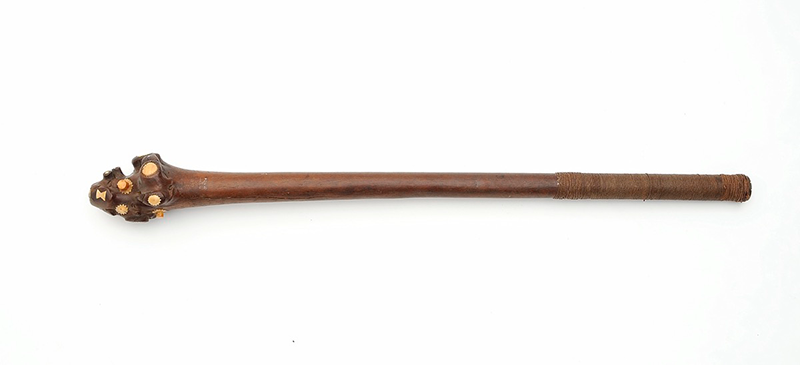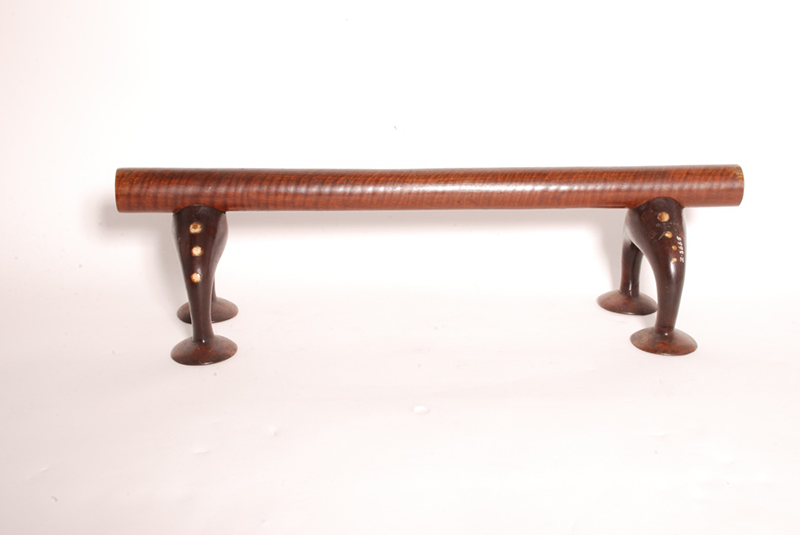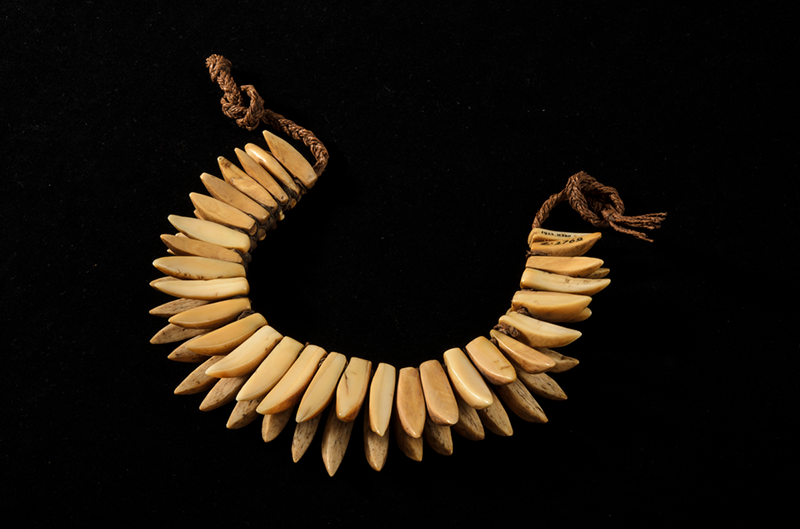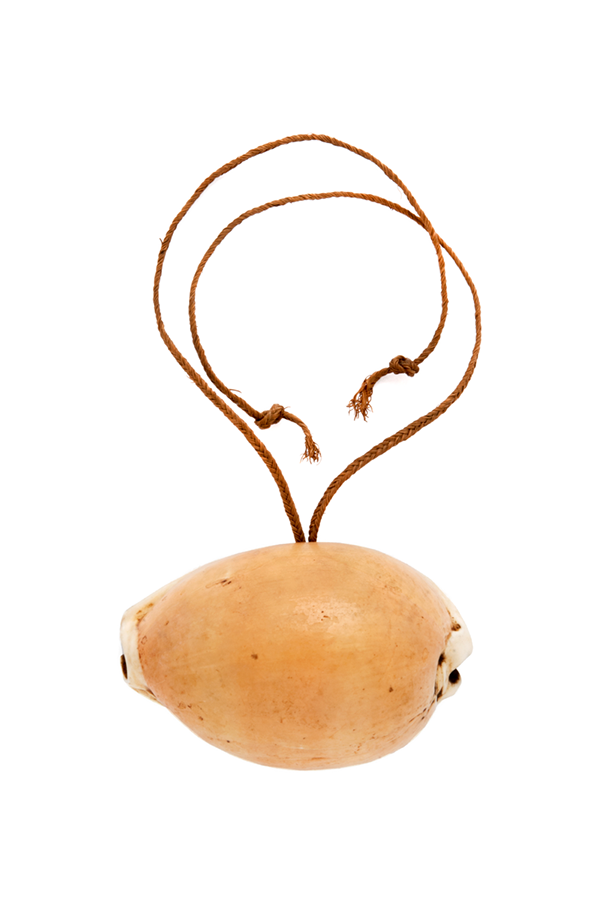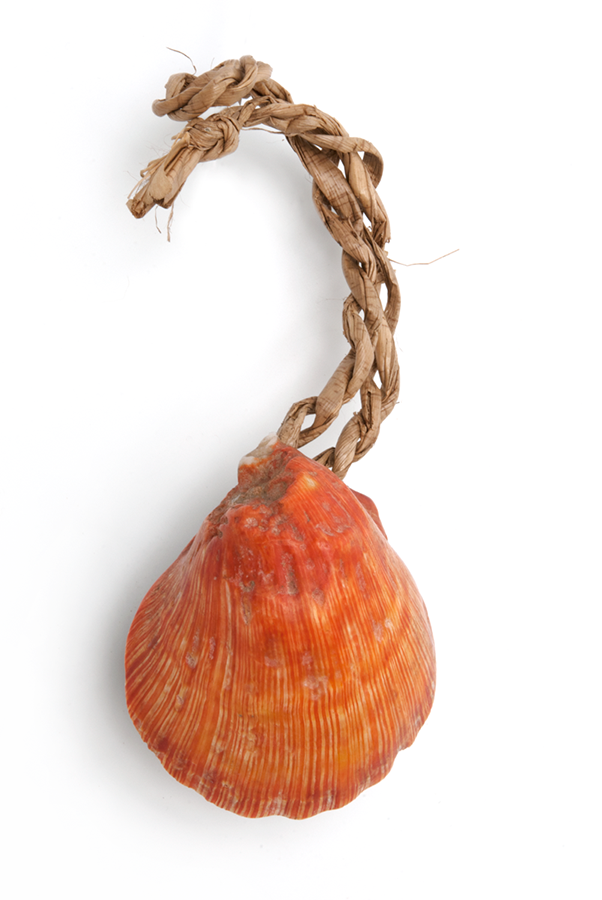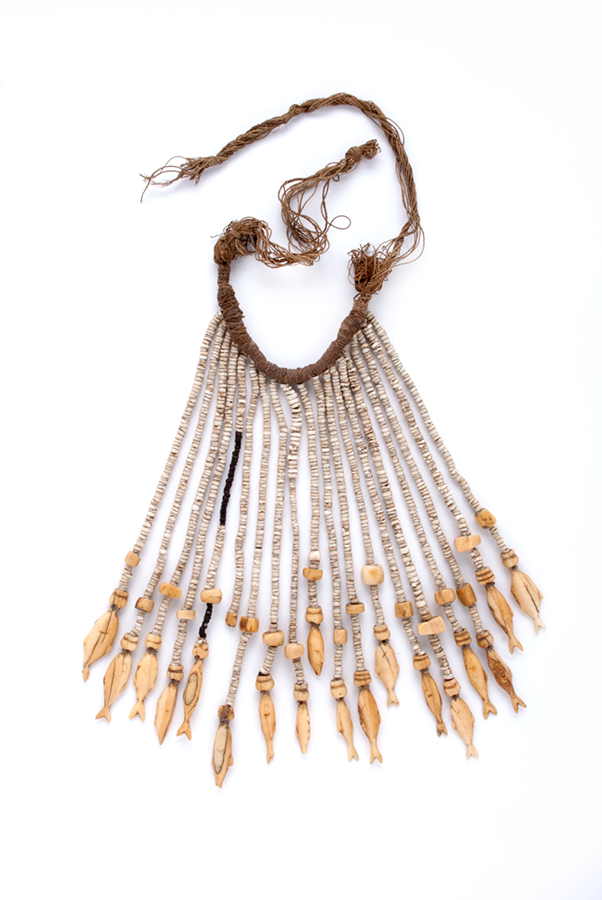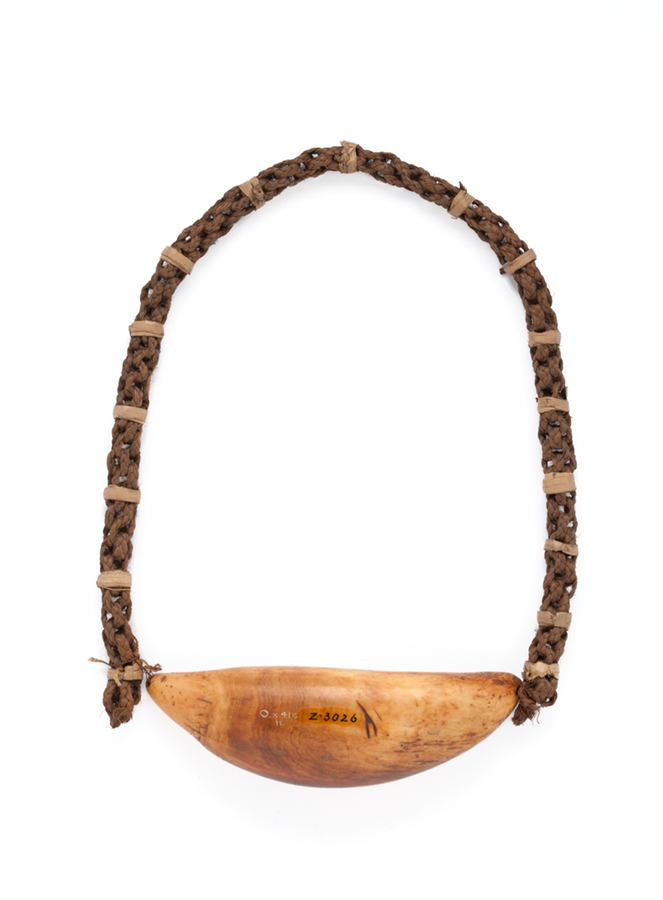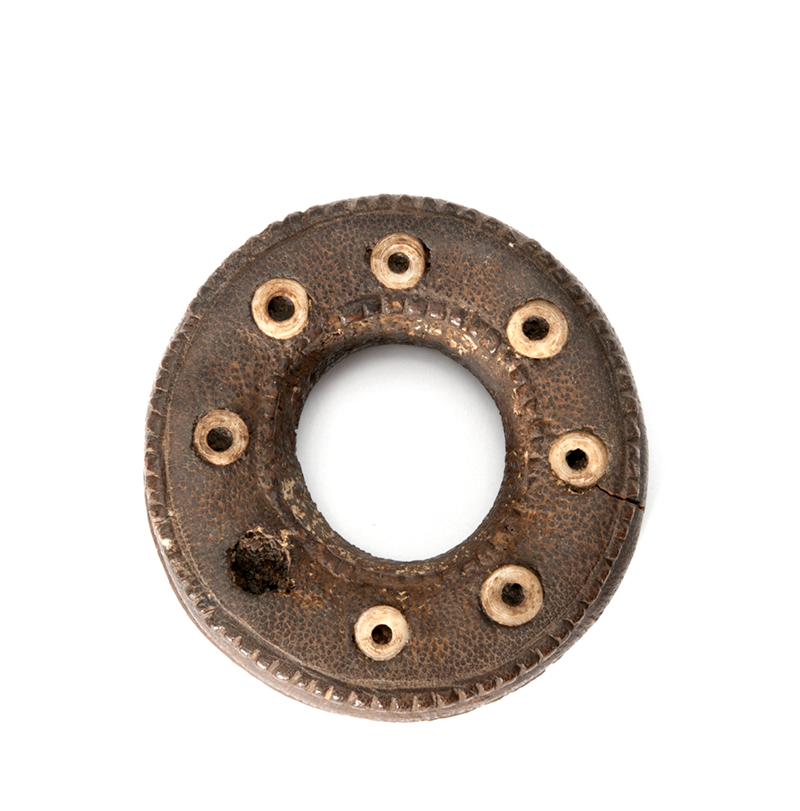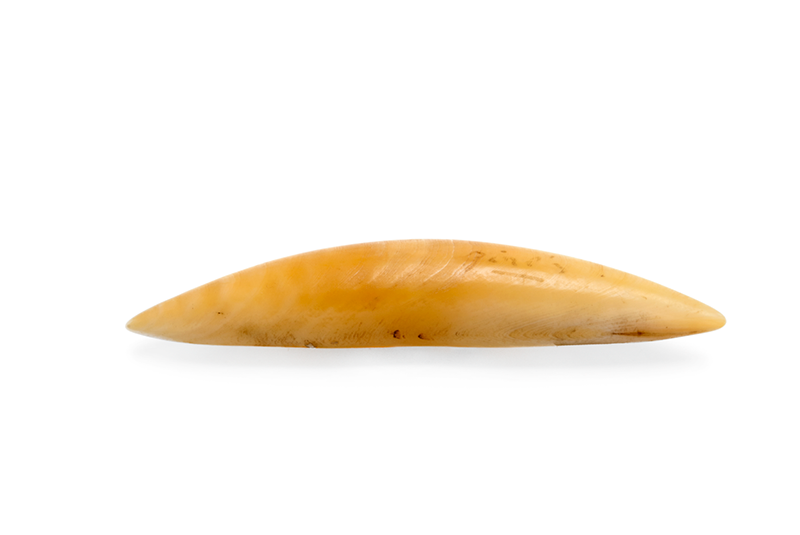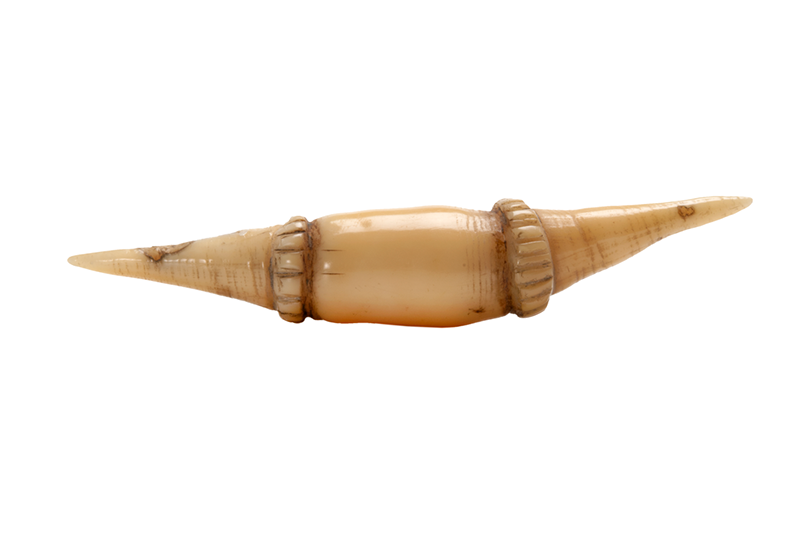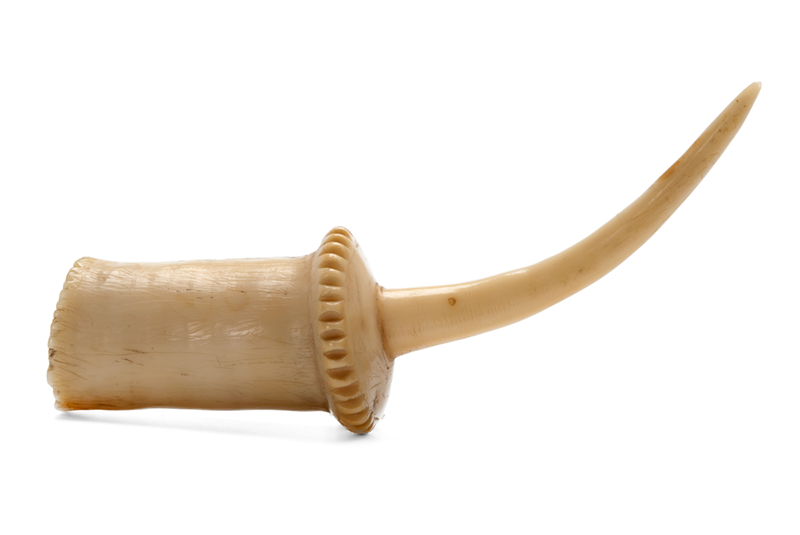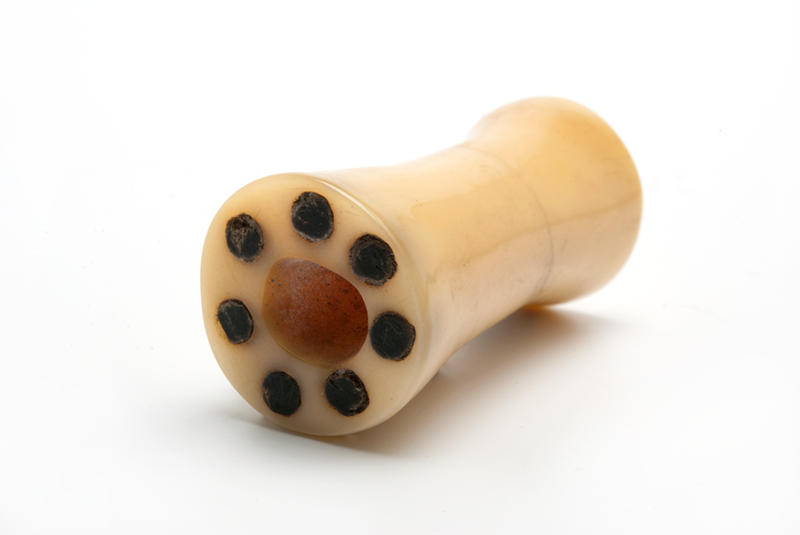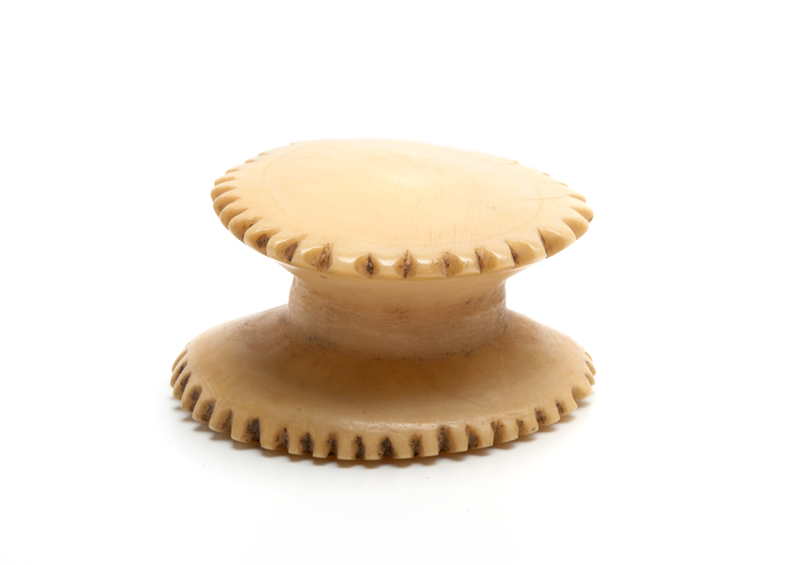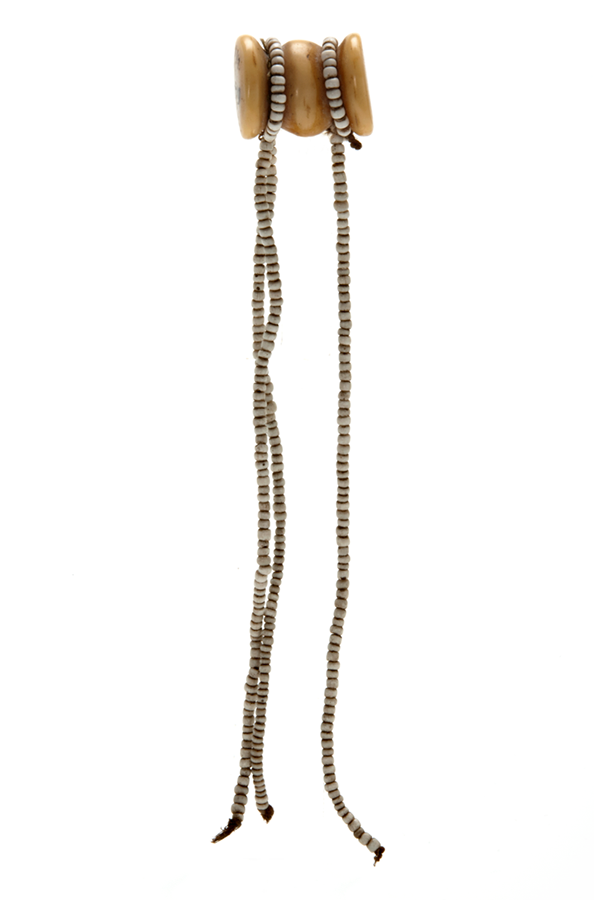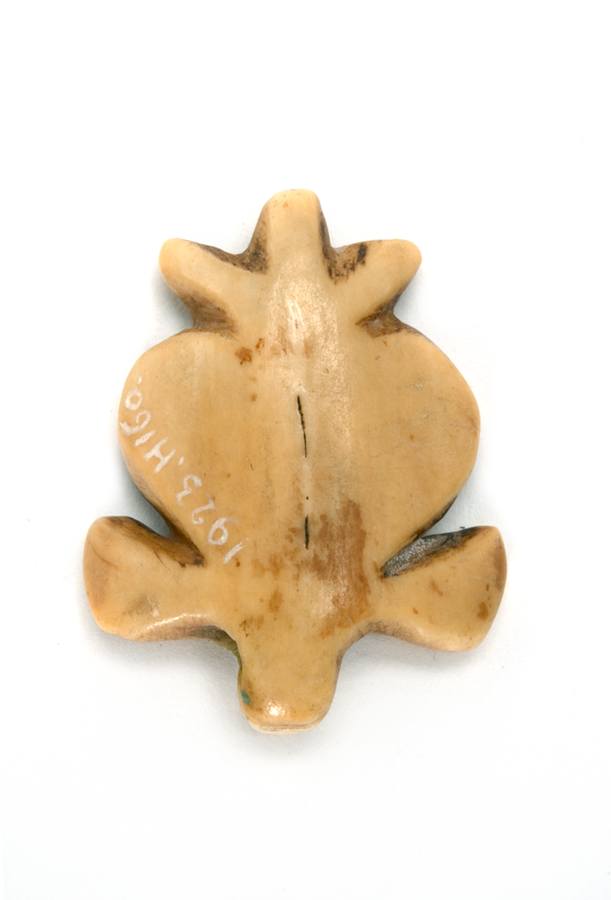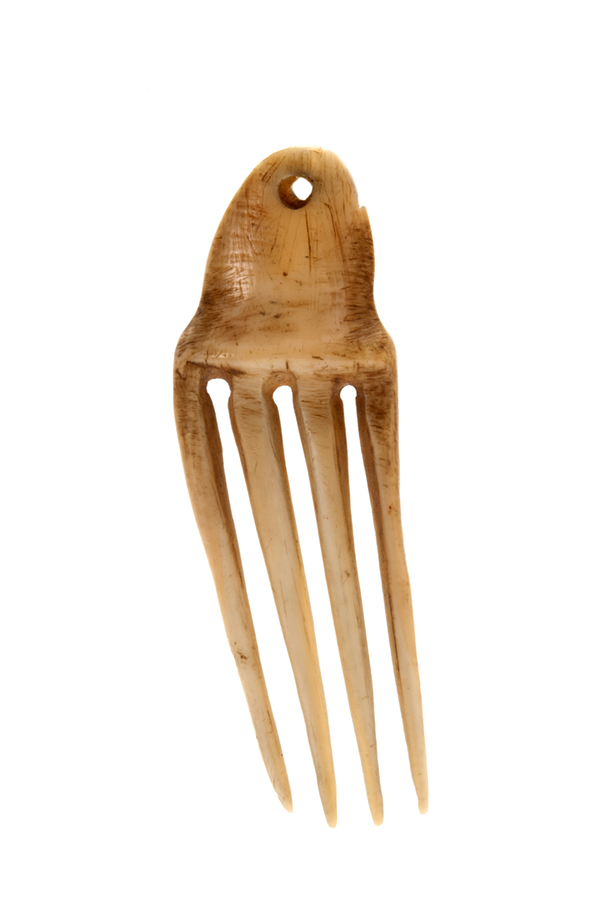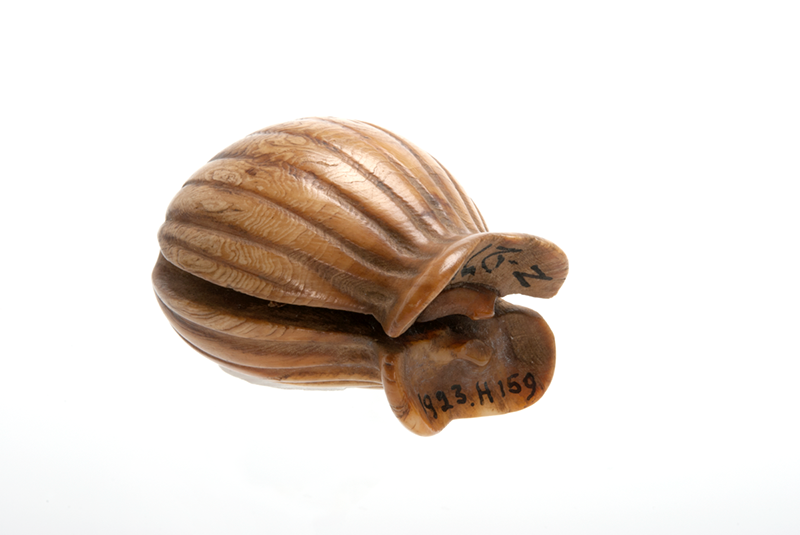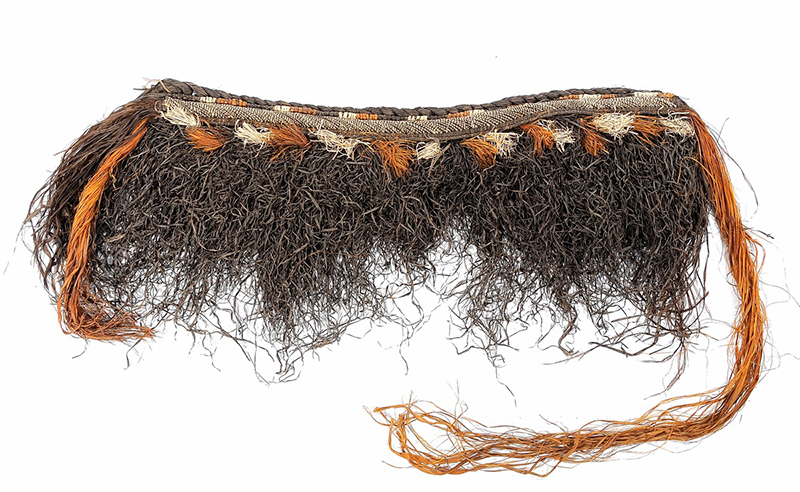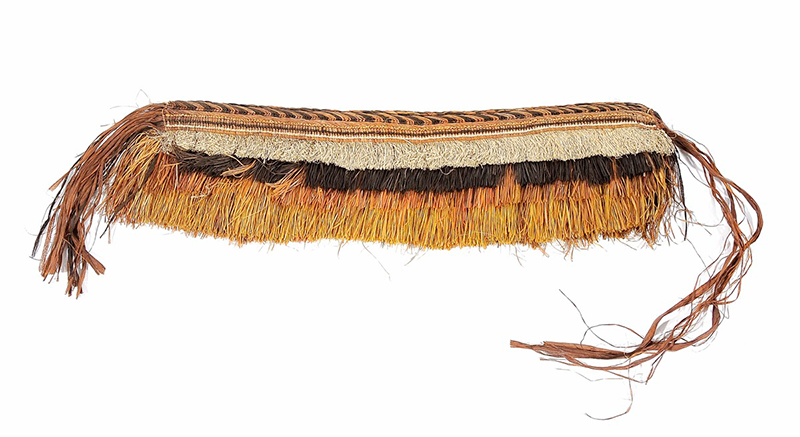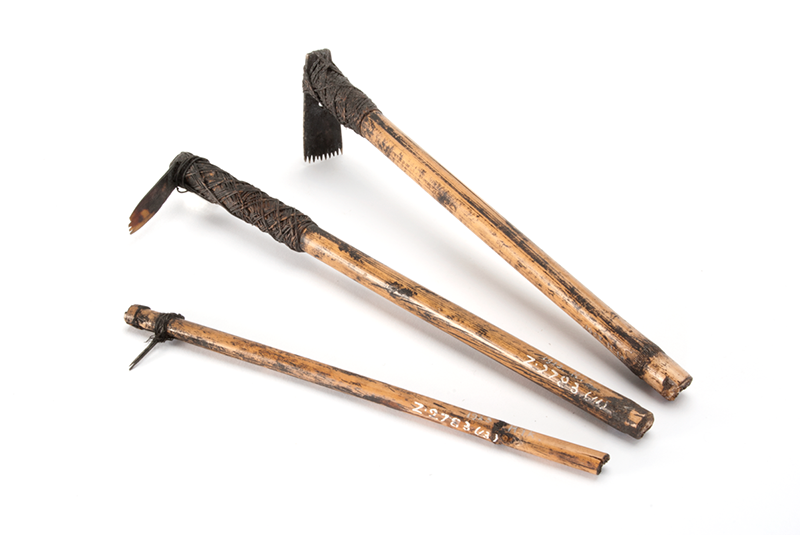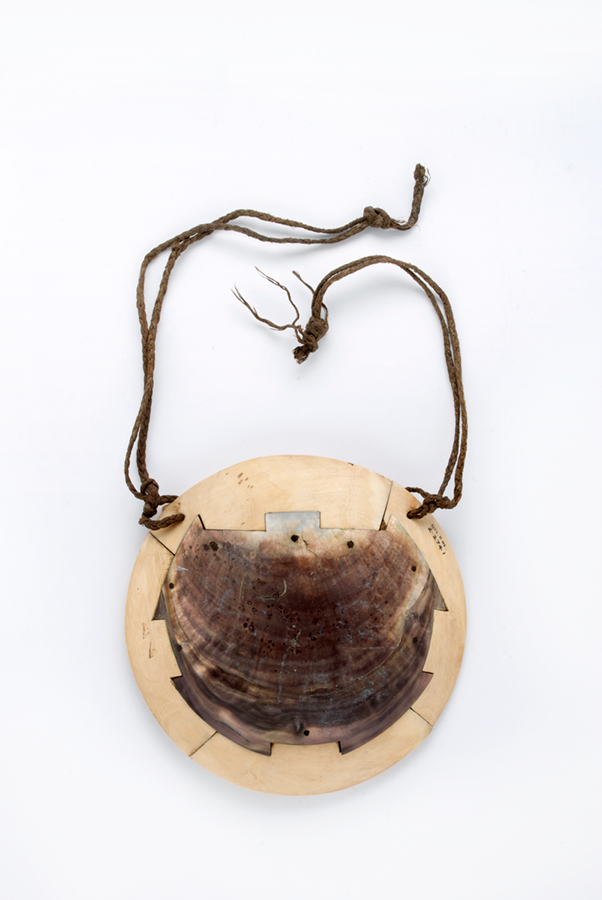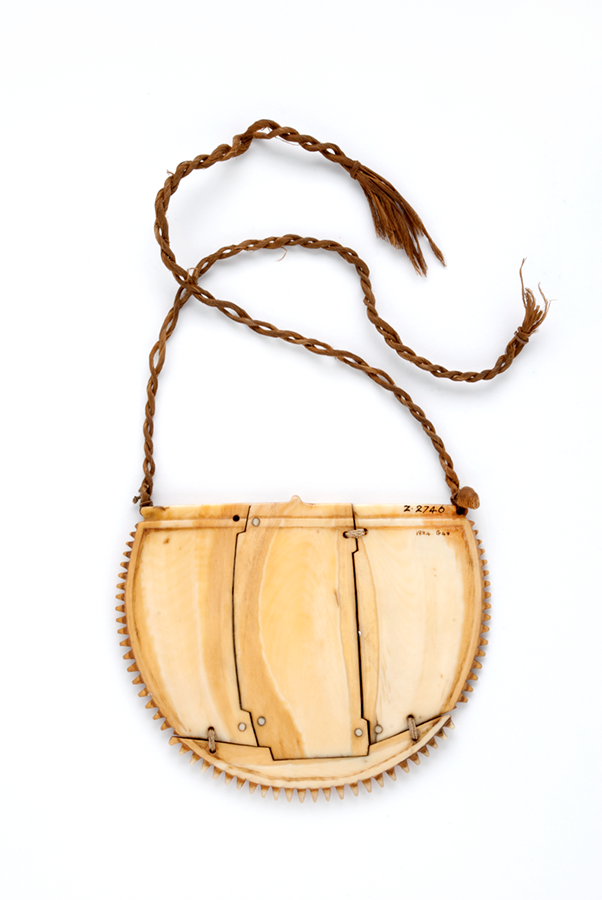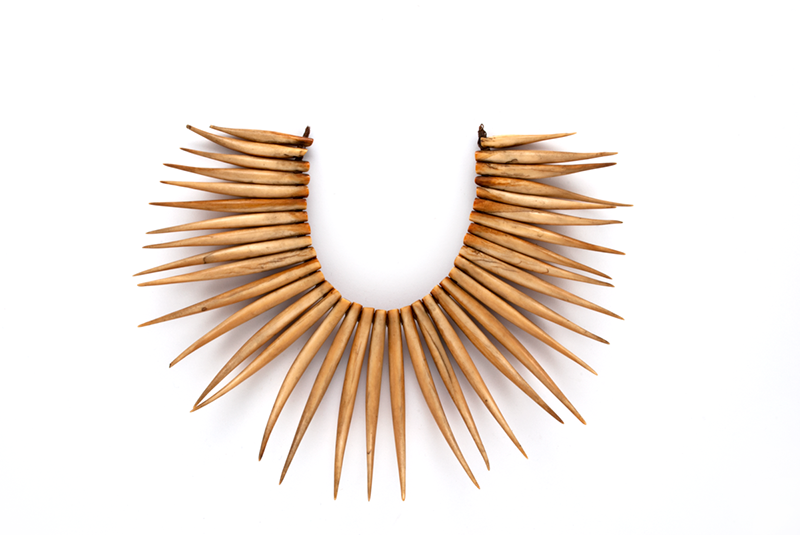'Viti', the indigenous name for Fiji, refers to the main island Viti Levu and by extension the region. Many distinctive features of Fijian culture of the late 18th and 19th centuries have continued into the present. The role of chiefs, the yaqona (kava) ceremony, and the presentation and exchange of valuables through gatherings known as solevu continue to be vitally important today.
Chief's yaqona ceremony in front of a house decorated with egg-cowrie (Ovula ovum) shells, indicating the high status of its residents. Cakobau's son, Ratu Timoci Tavanavanua, is seated on the right. Probably photographed by J.W.Waters, c.1880. Bau, Fiji. P.4051.ACH1
Chiefly prowess was demonstrated by control over resources and cherished valuables, the production of large amounts of masi, and agricultural surpluses. The proliferation and range of exquisite ornaments made from whale ivory are a testament to chiefly power. The chief's person was sacred and thereby tabu, spiritually potent and potentially dangerous. A chief's exalted status was marked by elaborate observances and prohibitions.
During the 19th century, the position of chiefs ranged from relatively independent leaders of clan and village groups to autocratic paramount chiefs who controlled large districts and developed far-reaching alliances and tributaries. In principle, a chief was a benevolent leader, linked by kinship to the members of his local group who provided loyalty and tribute in exchange for spiritual and physical protection, thus ensuring mutual prosperity. The reality was sometimes different for Fijians in areas where powerful competing chiefdoms held sway.
Chiefs continue to play important roles in Fijian communities today.
Explore the themes and objects in this section by using the drop down menu below.
Clubs were not only efficient weapons. They were also symbols of high status and vehicles connecting warriors to ancestor spirits through complex rituals. Their manufacture testifies to the high level of skills of Fijian and Western Polynesian wood-carvers.
Club, Totokia
This totokia is entirely carved with very fine zigzags pattern (tavatava) and a number of small figures: one figure holds a totokia club, one a turtle and another is being attacked by a shark.
Originally from Fiji. Acquired by A. von Hügel, c. 1895, London. Z 3097
Club, Bowai
Very large and heavy bowai. A cord of plaited coir threaded with white glass beads is attached around the handle. The size of this club suggests that it was owned by someone of high status.
Fiji. Collected by Sir A. Gordon, 1875-80. Z 3296
Club, Bowai
The surface of this bowai is inlaid with tiny discs of whale ivory and a few shell beads. A fibre cord would have been attached to the pierced butt.
Vuda, Narewa, Nadi, Viti Levu, Fiji. Collected by A. von Hügel, December 1875. Z 3205
Club, Vunikau
The head of this vunikau is inlaid with large delicately carved pieces of whale ivory. Some are protruding, others are flush with the surface of the wood. The handle is bound with coir cords (magimagi).
Fiji. Collected by Sir A. Gordon, 1875-80. Z 3174
Headrest, Kali
This kali is formed of a circular bar of casuarina wood (nokonoko) on two wooden pairs of feet, inlaid with pieces of whale ivory. It was given to Anatole von Hügel by Adi Kuila, the daughter of Cakobau, the powerful chief of Bau.
Bau, Fiji. Presented to A. von Hügel by Adi Kuila, 20 April 1876. Z 3665
Increased access to sperm whale ivory in the early 19th century resulted in a proliferation of high-status ornaments associated with chiefs. They demonstrate the power of chiefs to obtain highly valued materials and control the production of specialist craftsmen.
Necklace, Sisi
This unusual, perhaps unique, sisi is composed of one row of carved whale tooth and one row of tooth-like pendants made of whale bone. Strung on a plaited coir cord.
Saqunu, Ba, Viti Levu, Fiji. Collected by A. von Hügel, February 1876. Z 2762
Shell pendants, Bulikula & Sovui
Golden cowrie and spondylus shell pendants were worn by chiefs and priests at the base of the throat. The colour red was associated with chiefs and with Borutu, the spirit world.
Viti Levu, Fiji. Collected by A. von Hügel, 1875-77. Z 2764
Viti Levu, Fiji. Collected by Sir A. Gordon, 1875-80. Z 2708 B
Necklace
This exceptional necklace is composed of fish pendants and large beads made of sperm whale ivory, and small coconut shell beads strung on hibiscus fibre. Its unusual composition suggests influences from Tonga and/or Micronesia.
Fiji. Collected by Sir A. Gordon, c. 1876. Z 2770
Presentation whale tooth, Tabua
Tabua continue to be the most important of all Fijian valuables. The tooth is modified by sanding, worked into a crescent shape, and smoked and oiled to produce a rich red colour. Whale teeth were used to make a variety of high-status ornaments. Strung on a cord of coir and pandanus leaf strips.
Fiji. Collected by A. von Hügel, 1875-77. Z 3026
Ear ornaments, Saunidaliga
Vanua Levu, Fiji. Collected by A. von Hügel, 1875-77. Z 2720
Viti Levu, Fiji. Collected by A. von Hügel, 1875-77. Z 2771 A; Z 2771 B; Z 2771 G
Viti Levu, Fiji. Collected by A. von Hügel, 1875-77. Z 2718 A; Z 2718 E
Viti Levu, Fiji. Collected by A. von Hügel, 1875-77. Z 2719 B
Pendants
Whale ivory pendants in the shape of a turtle, a comb and a leba fruit.
Highlands Viti Levu, Fiji. Collected by A. von Hügel, 1875-77. Z 2722 G
Viti Levu, Fiji. Collected by A. von Hügel, 1875-77. Z 2754
Viti Levu, Fiji. Collected by A. von Hügel, 1875-77. Z 2722 D
Made of hibiscus fibre (vau) and fastened low on the hips, liku of this elaborate kind were worn in the 19th century by high-status women on formal occasions. They were also important presentation items used in ceremonial exchanges including solevu. The conversion of many Fijians to Christianity and encouragement from missionaries to adopt European clothing led to the decline and disappearance of liku as clothing.
In contrast to Tonga and Samoa, where men were tattooed, in Fiji only women received tattoos (qia). Female specialists applied designs around the hips and mouth by tapping small adzes or picks dipped in a black pigment made of candle-nut soot. The tools were composed of a bamboo shaft tipped with a blade made of bone, a thorn, a piece of turtle shell or sometimes a metal pin.
Fiji. Collected by A. von Hügel, 1875-77. Z 2783.8, 11 & 13
Tongan and Samoan canoe-builders were also renowned for making whale ivory necklaces and breastplates. Obtained through exchange or from communities settled locally, these objects were highly valued by Fijian chiefs. The engineering of the different elements forming a breastplate demonstrates the high level of skills involved in their making. In some cases, the ties are invisible at the front, and concealed by small ivory pegs at the back. In the 19th century, breastplates and necklaces were sometimes exchanged at large gatherings called solevu.
Breastplate, Civavonovono
Breastplate composed of four sections of whale ivory enclosing a turtle-shaped piece of pearl shell.
Koroinasau, Nadroga, Viti Levu, Fiji. Collected by A. von Hügel, 5 August 1876. Z 2741
Breastplate, Civatabua
The small protrusion along the top edge evokes the hinge of pearl oyster shells, from which civa breastplates were made.
Fiji. Collected by Sir A. Gordon, 1875-80. Z 2746
Necklace, Waseisei
Waseisei are formed of whale teeth cut into thin graduating tusks. They were popular throughout Western Polynesia and prized by Fijian chiefs.


